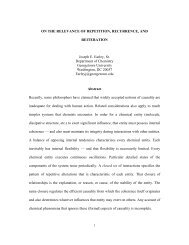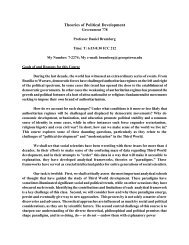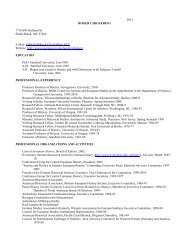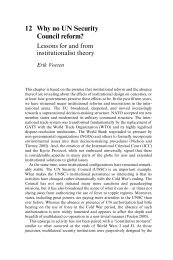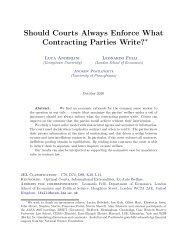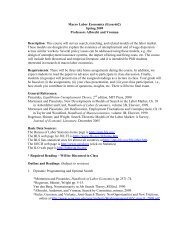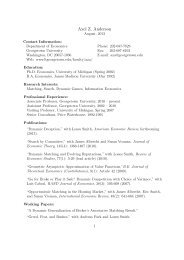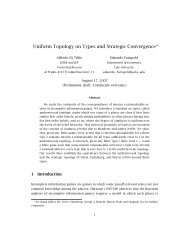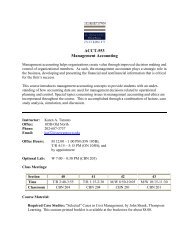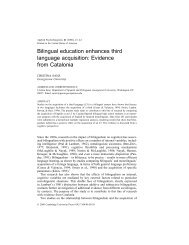- Page 1 and 2: UNIVERSITY OF CALIFORNIASANTA CRUZD
- Page 3 and 4: TABLE OF CONTENTSGLOSS ABBREVIATION
- Page 5 and 6: 3 The Representation of Gender: Fir
- Page 7 and 8: 2 Gendered Plurals and Feminine Suf
- Page 9 and 10: GLOSS ABBREVIATIONS3 Third personAC
- Page 11 and 12: with two different slots for plural
- Page 13 and 14: Portions of this work were presente
- Page 15 and 16: CHAPTER 1:INTRODUCTION1 THEMESThe i
- Page 17 and 18: assumptions are laid out in Section
- Page 19 and 20: of Amharic (Leslau 1995) is the cur
- Page 21 and 22: (4) [[ CP nnat-u ndä-mot-ätt ] tn
- Page 23 and 24: 2004, Kramer 2006 on differential o
- Page 25 and 26: nominalized verbal forms (as sugges
- Page 27 and 28: future. I hope also that the recent
- Page 29 and 30: To be more specific, Distributed Mo
- Page 31 and 32: Pānịnian Principle states that a
- Page 33 and 34: (2001, 2007) and Arad (2003, 2005)
- Page 35 and 36: the realization of D when it is obl
- Page 37: CHAPTER 2:DEFINITE MARKING IN AMHAR
- Page 41 and 42: (4) a. tllk’-u bet big-DEF house
- Page 43 and 44: c. [Almaz k’ondo ndä-hon-ätt y
- Page 45 and 46: (12) k’ondo-w tllk’(-u) k’äy
- Page 47 and 48: elative clause complementizer 5 ),
- Page 49 and 50: analyzed, the fact that possessive
- Page 51 and 52: 3.1 D versus [DEF]Both Ouhalla 2004
- Page 53 and 54: (20) Agreea. Agree holds between a
- Page 55 and 56: morphological realization of the sy
- Page 57 and 58: Zwicky (1996). It is crucial to det
- Page 59 and 60: find a host in its base position. I
- Page 61 and 62: pronouns, which are prosodic 2P cli
- Page 63 and 64: easons not to accept the structure
- Page 65 and 66: (31) DP (Spell-Out and Linearizatio
- Page 67 and 68: AP) have specifiers that are morpho
- Page 69 and 70: The definite marker thus receives a
- Page 71 and 72: also contains the specifier positio
- Page 73 and 74: e the case that other languages wit
- Page 75 and 76: a precedence relation on items that
- Page 77 and 78: The Latin conjunction -que is often
- Page 79 and 80: The account of phase impenetrabilit
- Page 81 and 82: The variation generates the basic f
- Page 83 and 84: 5.1 Free RelativesAmharic free rela
- Page 85 and 86: (52) [ DP -u [ NP [ CP zzih yämät
- Page 87 and 88: (56) a. *bunna räddim näggade b.
- Page 89 and 90:
In (59), the topmost N node is a M-
- Page 91 and 92:
Even extremely complex numerals can
- Page 93 and 94:
implausible for a very internally c
- Page 95 and 96:
Overall, this section has extended
- Page 97 and 98:
There are also some Amharic-interna
- Page 99 and 100:
The relevant Feature Copying rule f
- Page 101 and 102:
(79) tnn-wa k’äyy(-wa) mäkinasm
- Page 103 and 104:
Local Dislocation will attach the i
- Page 105 and 106:
6.3 Definite Marking in Demonstrati
- Page 107 and 108:
This mechanism can be thought of as
- Page 109 and 110:
specifier is filled and (as per the
- Page 111 and 112:
definiteness agreement on the adjec
- Page 113 and 114:
syntactic operations can access any
- Page 115 and 116:
2 GENDER IN NOMINALS2.1 The FactsAs
- Page 117 and 118:
(4) a. tämari-w tämari-wastudent-
- Page 119 and 120:
säw as a default masculine is ‘p
- Page 121 and 122:
For example, magav without any suff
- Page 123 and 124:
of a copular clause (see (5)). Also
- Page 125 and 126:
The Ethio-Semitic language Ge’ez
- Page 127 and 128:
Amharic as well for the vast majori
- Page 129 and 130:
She assumes that en Pere ‘Pere’
- Page 131 and 132:
(17) a. afrikawi-yan wändmm-ott-at
- Page 133 and 134:
example, a verb like hammer consist
- Page 135 and 136:
almost every other kind of animate
- Page 137 and 138:
Amharic, the roots associated with
- Page 139 and 140:
this analysis, there is simply nowh
- Page 141 and 142:
(29) D, [DEF], [+FEM], [-PL] ↔ -w
- Page 143 and 144:
(33) nP3n √Pg√For many nominals
- Page 145 and 146:
inanimates are masculine and can th
- Page 147 and 148:
(36) Same-Root NominalsRoot: no gen
- Page 149 and 150:
This idea is workable for the licen
- Page 151 and 152:
meaning of the nominal and interpre
- Page 153 and 154:
(41) cP3c NP[iCLASS] !N[u +FEM]Fram
- Page 155 and 156:
einstated (or preserved) in PF beca
- Page 157 and 158:
morphologically expressed!), it eit
- Page 159 and 160:
without any need for a look-back me
- Page 161 and 162:
together, and I review several prev
- Page 163 and 164:
specified include inanimates and ep
- Page 165 and 166:
Many of the analyses above divide n
- Page 167 and 168:
under plain n with no [+/-FEM] feat
- Page 169 and 170:
presupposition that the discourse r
- Page 171 and 172:
(47) Root: / l b s/Verb: läbbäsä
- Page 173 and 174:
pleasing, but perhaps workable. How
- Page 175 and 176:
(50) Infinitivesa. säbbärä ‘br
- Page 177 and 178:
All these derived nominals are same
- Page 179 and 180:
may be present syntactically in a f
- Page 181 and 182:
CHAPTER 4:NUMBER IN AMHARIC NOMINAL
- Page 183 and 184:
(2) ld-u mäs’haf wässäd-ächil
- Page 185 and 186:
Some nominals undergo nonconcatenat
- Page 187 and 188:
number is a feature on the root. 4
- Page 189 and 190:
Amharic results from the spell out
- Page 191 and 192:
In (7)a, the category-neutral conso
- Page 193 and 194:
Arad (2003, 2005:Ch. 7) also provid
- Page 195 and 196:
The vocabulary items in (12) raise
- Page 197 and 198:
ule (for forming regular plurals).
- Page 199 and 200:
There is one additional semantic id
- Page 201 and 202:
specific claim that the combination
- Page 203 and 204:
exactly what is needed for the Amha
- Page 205 and 206:
toponyms and results in a nominal f
- Page 207 and 208:
However, the double plurals also su
- Page 209 and 210:
3.3.2 Other n AccountsImportant sup
- Page 211 and 212:
lexical. Needless to say, regular p
- Page 213 and 214:
However, there are also ‘irregula
- Page 215 and 216:
irregular and regular plural inflec
- Page 217 and 218:
plurals) and irregular plurals that
- Page 219 and 220:
the same; both contain a plural fea
- Page 221 and 222:
system of Amharic and a mixture res
- Page 223 and 224:
at all. Moreover, it is not fully e
- Page 225 and 226:
Moving on to irregular plurals, L08
- Page 227 and 228:
n[+PL] combines with √XAZEYR to f
- Page 229 and 230:
The ordering here can be affected b
- Page 231 and 232:
I assume that relative clauses are
- Page 233 and 234:
(45) Proposal 1: YP = FocusP, XP =
- Page 235 and 236:
(49) DP3D NumP → [D * CP …]3CP
- Page 237 and 238:
the independent analysis. Despite i
- Page 239 and 240:
and Torrego (2007) propose that val
- Page 241 and 242:
singular. Since irregular plurals d
- Page 243 and 244:
the number feature from n, as well
- Page 245 and 246:
In (57), the head X is the probe: i
- Page 247 and 248:
It is not immediately clear what ki
- Page 249 and 250:
vocabulary items for the category n
- Page 251 and 252:
The feature sharing analysis in gen
- Page 253 and 254:
or on both morphologically. However
- Page 255 and 256:
The dependence on n[+PL] makes an i
- Page 257 and 258:
plurals. However, these different o
- Page 259 and 260:
for Borer’s (2008, 2009, forthcom
- Page 261 and 262:
plurals have distinct masculine and
- Page 263 and 264:
The Subset Principle ensures that a
- Page 265 and 266:
(5) kä-2 i 500 bë-lay yämmi-hon-
- Page 267 and 268:
(8) ityop’p’yawi ‘Ethiopian (
- Page 269 and 270:
2.2 Plurals and The Feminine Suffix
- Page 271 and 272:
j. k’ddus k’ddstsaintfemale sai
- Page 273 and 274:
feature sharing. I posited that Num
- Page 275 and 276:
However, there is another option fo
- Page 277 and 278:
(22) Num n[-PL][-PL][+FEM]At Vocabu
- Page 279 and 280:
(26) a. mänäk w s-it-ottnunsb. mu
- Page 281 and 282:
(28) a. *mänäkos-it-an, *mänakos
- Page 283 and 284:
(32) -awi Paradigm for ‘Ethiopian
- Page 285 and 286:
corresponds to irregular plural mor
- Page 287 and 288:
(40) afrik-awi-t-wa agär Burkina F
- Page 289 and 290:
To sum up, I initially showed that
- Page 291 and 292:
gender features indicates that the
- Page 293 and 294:
how the GNN analysis of number and
- Page 295 and 296:
(49) a. nnäzziya säw-ott b. nnäz
- Page 297 and 298:
Only certain adjectives participate
- Page 299 and 300:
‘honored.’ The adjective k’dd
- Page 301 and 302:
(65) a. tnn-*(ott)-u tämari-wottfe
- Page 303 and 304:
Although some quantifiers and numer
- Page 305 and 306:
determiners specifically retained a
- Page 307 and 308:
agreement in that it involves featu
- Page 309 and 310:
A = Mostly, B = NoHPSG approaches,
- Page 311 and 312:
This accords with results from Chap
- Page 313 and 314:
intermediate projection between D a
- Page 315 and 316:
features, they will not be able to
- Page 317 and 318:
prevented from happening in the syn
- Page 319 and 320:
features (Y and Z, Z and lowest X,
- Page 321 and 322:
The idea that a shared feature can
- Page 323 and 324:
Overall, the concord facts investig
- Page 325 and 326:
position where the moved element ca
- Page 327 and 328:
many larger issues are at stake if
- Page 329 and 330:
CHAPTER 6:CONCLUSIONS1 INTRODUCTION
- Page 331 and 332:
(1) DP3D NumP3Num nP3n √The quirk
- Page 333 and 334:
projections are best identified as
- Page 335 and 336:
thesis has provided a firm foundati
- Page 337 and 338:
general) was proposed in order to e
- Page 339 and 340:
this was seen in Chapter 4 for plur
- Page 341 and 342:
REFERENCESNB: Ethiopian names are a
- Page 343 and 344:
Bender, M.L., J.D. Bowen, R.L. Coop
- Page 345 and 346:
Chomsky, Noam. 2001. Derivation by
- Page 347 and 348:
Embick, David. 2008. Localism versu
- Page 349 and 350:
Gribanova, Vera. 2009. The phonolog
- Page 351 and 352:
Heller, Daphna. 2002. On the constr
- Page 353 and 354:
Kramer, Ruth. 2007. Nonconcatenativ
- Page 355 and 356:
McCarthy, John. 2000. Faithfulness
- Page 357 and 358:
Postal, Paul M. 1969. On so-called
- Page 359 and 360:
Steele, Susan. 1978. Word order var



